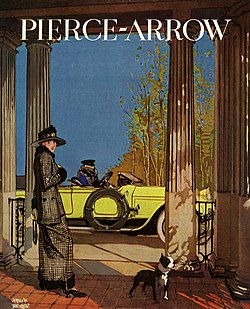| Former type | Automobile manufacturing | |||
|---|---|---|---|---|
| Industry | Automotive | |||
| Genre | Sedans, touring cars Commercial trucks, fire trucks, camp trailers, motorcycles, and bicycles | |||
| Founded | 1901 | |||
| Founder(s) | George N. Pierce | |||
| Defunct | 1938 | |||
| Headquarters | Buffalo, New York, United States | |||
| Area served | United States | |||
| Products | vehicles Automotive parts | |||
The forerunner of Pierce-Arrow was established in 1865 as Heinz, Pierce and Munschauer. The company was best known for its household items, especially its delicate, gilded birdcages. In 1872, George N. Pierce bought out the other two, changed the name to George N. Pierce Company, and, in 1896, added bicycles to the product line. The company failed in its attempt to build a steam-powered car in 1900 under license from Overman, but by 1901 had built its first single-cylinder, two-speed, no-reverse Motorette with an engine licensed from de Dion. In 1903, it produced a two-cylinder car, the Arrow.
In 1904, Pierce decided to concentrate on making a larger, more luxurious car for the upscale market, the Great Arrow. This became Pierce's most successful product. The solidly built, four-cylinder car won the Glidden Trophy in 1905, an endurance run to celebrate the most reliable car. Thirty-three cars entered the 1100-mile race from New York City to Bretton Woods, New Hampshire, won by Percy Pierce in a Great Arrow.
The noted industrial architect Albert Kahn designed the Pierce Arrow Factory Complex at Elmwood Avenue and Great Arrow Avenue in about 1906. It was listed on the National Register of Historic Places in 1974. George Norman Pierce sold all rights in the company in 1907, and he died three years later. In 1908, Pierce Motor Company was renamed The Pierce-Arrow Motor Car Company.
In 1909, US President William Howard Taft ordered two Pierce-Arrows (and two White Model M Tourers) to be used for state occasions, the first official cars of the White House.
The Pierce-Arrow's engine capacity started as 11.7 L and later was 13.5 L. In 1910 Pierce dropped the rest of its 4-cylinder models and focused exclusively on 6-cylinder cars. The model 6-36, 6-48, and 6-66 continued for the next decade. Herbert M. Dawley (later a Broadway actor-director) joined Pierce-Arrow in 1912, and designed almost every model until 1938. Up until 1914, Pierce-Arrow also made a line of motorcycles.
The Pierce-Arrow was a status symbol, owned by many Hollywood stars and tycoons. Most of the royalty of the world had at least one Pierce-Arrow in its collection. Some have described Pierce and two of its rivals among American luxury cars, Peerless and Packard, as the "Three P's of Motordom." Industrial efficiency expert Frank Gilbreth extolled the virtues of Pierce-Arrow, in both quality and in its ability to safely transport his large family. Its wheelbase was 12 ft 3 in (3.73 m). Actor Sessue Hayakawa famously drove a custom ordered gold plated Pierce-Arrow as a status symbol which angered American families and instilled disdain towards Asian males due to his extravagant lifestyle and romances, which resulted in negative stereotypes of Asian men.
Pierce-Arrow advertisements were artistic and understated. Unusual for car advertising, the image of the car was in the background rather than the foreground of the picture. Usually only part of the car was visible. The Pierce-Arrow was typically depicted in elegant and fashionable settings. Some advertisements featured the car in places a car would not normally go, such as the West and other rural settings, a testament to the car's ruggedness and quality.
Several second-hand Pierce-Arrow cars were bought by fire departments, stripped down to the chassis and engine, the wheelbase lengthened, and built back into fire engines. Some of these fire engines were in service for up to 20 years.
1928–1933
In 1928, the Studebaker Corporation of South Bend, Indiana, gained control of the Buffalo firm. The association was to last for five years, with moderate benefits to both companies' engineering departments, which continued to function as separate entities. Pierce-Arrow also gained a dealer network, as the cars were sold through Studebaker dealerships. Under Studebaker ownership Pierce-Arrow retired the venerable 6-cylinder engine and in 1929 introduced an L-head [straight-eight engine], which displaced 366 cubic inches.1933 Silver Arrow and the end of the line
In 1933, Pierce-Arrow unveiled the radically streamlined Silver Arrow in a final attempt to appeal to the wealthy at the New York Auto Show.
The car was well received by the public and the motoring press, being
announced with the slogan "Suddenly it's 1940!" Pierce sold five
examples but, since it was priced at $10,000 during the worst of the Depression, the rich were hesitant to spend so much. The bodies were built at Studebaker,
which subsequently assisted in rolling out a lower-priced production
model. This, however, lacked many luxury features of the show car and
still failed to generate enough sales.
The Rio Grande Southern Railroad converted five Pierce-Arrow automobiles (and a couple of Buicks) into motorized railcars, effectively buses and trucks on rail wheels. The nickname Galloping Goose was soon applied to these vehicles, based on their waddling motion and honking horn. All still survive.
Pierce was the only luxury brand that did not field a lower-priced car (e.g., the Packard 120) to provide cash flow, and without sales or funds for development, the company declared insolvency in 1938 and closed its doors. The final Pierce-Arrow assembled was built by Karl Wise, the firm's chief engineer, from parts secured from the company's receivers. Pierce's remaining assets (which probably would include the forty Arrows made in October 1938) were sold at auction on Friday, May 13, 1938.
The factory equipment used to make Pierce-Arrow V-12 engines was bought by Seagrave Fire Apparatus, which used it to make engines for fire engines.
















